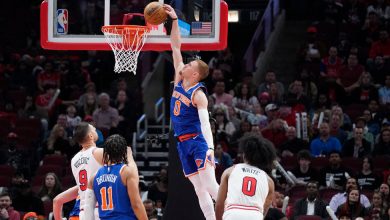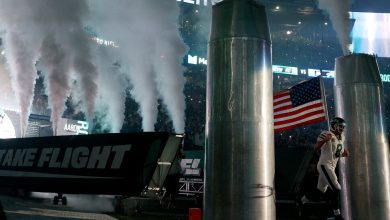M.L.B.’s Collective Bargaining Agreement Expires With Lockout to Follow

IRVING, Texas — For the first time in nearly three decades, Major League Baseball is headed toward a work stoppage.
After the owners of M.L.B.’s 30 clubs and the players failed to reach a new collective bargaining agreement before the expiration of the previous five-year pact at 11:59 p.m. Eastern on Wednesday, the league was expected to enact a lockout. It would be the latest chapter in fraught labor relations between the sides in recent years.
While a lockout is not a requirement, the move is the owners’ cudgel and it has previously been used by owners in the four major men’s North American professional sports leagues in similar instances. After a flurry of free agency activity leading up to Wednesday, a lockout would bring the sport to a standstill. Teams would not be allowed to talk to players, make major league signings or swing trades.
This would be the ninth work stoppage in M.L.B. history, and the fourth lockout. The last time owners locked out the players was before the 1990 season. None of the previous three lockouts led to the cancellation of regular-season games. In 1990, the 32-day lockout eliminated most of spring training but the full schedule of regular-season games was played, simply starting a week later than usual.
The last time a work stoppage damaged the regular season, though, was the 1994-95 players’ strike. It prematurely ended the 1994 campaign, canceled that year’s World Series and bled into the next season, costing the league more than 900 games.
Players successfully staved off the implementation of a salary cap with the strike but the episode left lasting damage on the sport. Still, there was labor peace over the following decades. And baseball grew into an $11 billion a year industry, with superstar players continually breaking records for contract size.
But the mistrust between team owners and players has increased over the years. Two years after the now-expired C.B.A. was enacted before the 2017 season, the players’ union hired a new lead negotiator, Bruce Meyer, a veteran labor litigator who had worked for or with the players’ unions of the N.B.A., N.H.L. and N.F.L. The expired baseball C.B.A. is viewed as having further tilted the balance in the owners’ favor, with changes such as harder caps on international spending and stricter penalties for higher payrolls.
Since then, the union and players have become increasingly vocal about what they considered flaws in the system. The tension between the owners and players came to a head last year during bitter negotiations over staging the 2020 regular season after play had been suspended during spring training by the coronavirus pandemic. Some players became more active in union affairs and more resolute in their opposition to how owners were running their teams.
“We have a pretty good war chest behind us of money that we can allocate to players,” said pitcher Max Scherzer, a top union representative, during his introductory news conference on Wednesday with the Mets. Scherzer attended the news conference, which was conducted virtually, from the Dallas area hotel where labor negotiations occurred.
Over the past five years, Scherzer said the union has been amassing money to weather this labor dispute. He continued, “The best-case scenario is not to tap it. Obviously, hopefully, we get a deal at some point in time, but just know as players, we’re steadfast in our belief of how we see the game.”
Throughout this year, M.L.B. and the union have met virtually and in person, with each side offering proposals and tweaks. The union’s first proposal on core economic issues came in May, while the league’s was in August. They found little common ground — strongly disagreeing on proposed changes to revenue sharing, service time accrual and free agency — even during face-to-face sessions on the day the C.B.A. expired.
This week, M.L.B. officials and the seven club owners who comprise the league’s labor policy committee came to Texas to bargain directly with the players during the union’s annual off-season executive board meetings. M.L.B. made a new proposal on core economic issues last week, while the union made another on Tuesday — both of which the other side rejected.
Although the groups remained significantly apart, the season would not yet be in jeopardy and negotiations between the sides could continue even after a lockout is enacted. Spring training is scheduled to start in mid February and opening day is scheduled for March 31.
At the owners’ meetings in Chicago in mid November, M.L.B. Commissioner Rob Manfred, who had played a role in the sport’s recent labor peace, argued an off-season work stoppage was more palatable than one that hurt the season. “I can’t believe there’s a single fan in the world who doesn’t understand that an off-season lockout that moves the process forward is different than a labor dispute that costs games,” he told reporters then.
Players have wanted a series of improvements, some of which have been rejected by M.L.B.: getting young players (who are cheaper and have been relied upon more) compensated sooner in their careers, allowing players to reach salary arbitration and free agency sooner, raising luxury tax thresholds (from $210 million now to $245 million), reducing revenue sharing among teams and ways that could curb service time manipulation, and forcing teams to be more competitive through a handful of measures, including changes to the amateur draft.
Owners, on the other hand, believe M.L.B. players have the best deal in professional sports and viewed the union’s proposals as substantial modifications to longstanding aspects of the economic model. M.L.B. has also said it wants to improve the competitive balance among teams but has proposed different ways to accomplish that than the union.
Among its proposals, some of which have been rejected by the union: an N.B.A.-style lottery format for the first three picks in the draft that could help prevent so-called tanking, a club payroll floor ($100 million) along with a lower luxury tax threshold ($180 million) — or more modest luxury tax threshold increases (starting with $214 million) without a floor but with steeper rates for going over, overhauling the salary arbitration system, smaller increases to league minimum salaries, making free agency based on age and expanding the playoffs (from 10 to 14 teams), which would net more revenue.
In recent proposals, M.L.B. has shown a willingness to get rid of the qualifying offer system, which attaches draft picks to certain free-agent players, while the players offered a 12-team expanded postseason.
On Wednesday afternoon at the players’ hotel, Andrew Miller, a top union representative who pitched for the St. Louis Cardinals this year, and Meyer walked off with Dick Monfort, the Colorado Rockies’ owner and the chair of the league’s labor committee; Dan Halem, M.L.B.’s lead negotiator; and Patrick Houlihan, M.L.B. deputy general counsel. Seven minutes later, the M.L.B. officials returned, gathered their belongings and left.
The players were then told that no more meetings with M.L.B. were planned for the rest of the day. And at some point on Thursday, the lockout announcement was expected.




